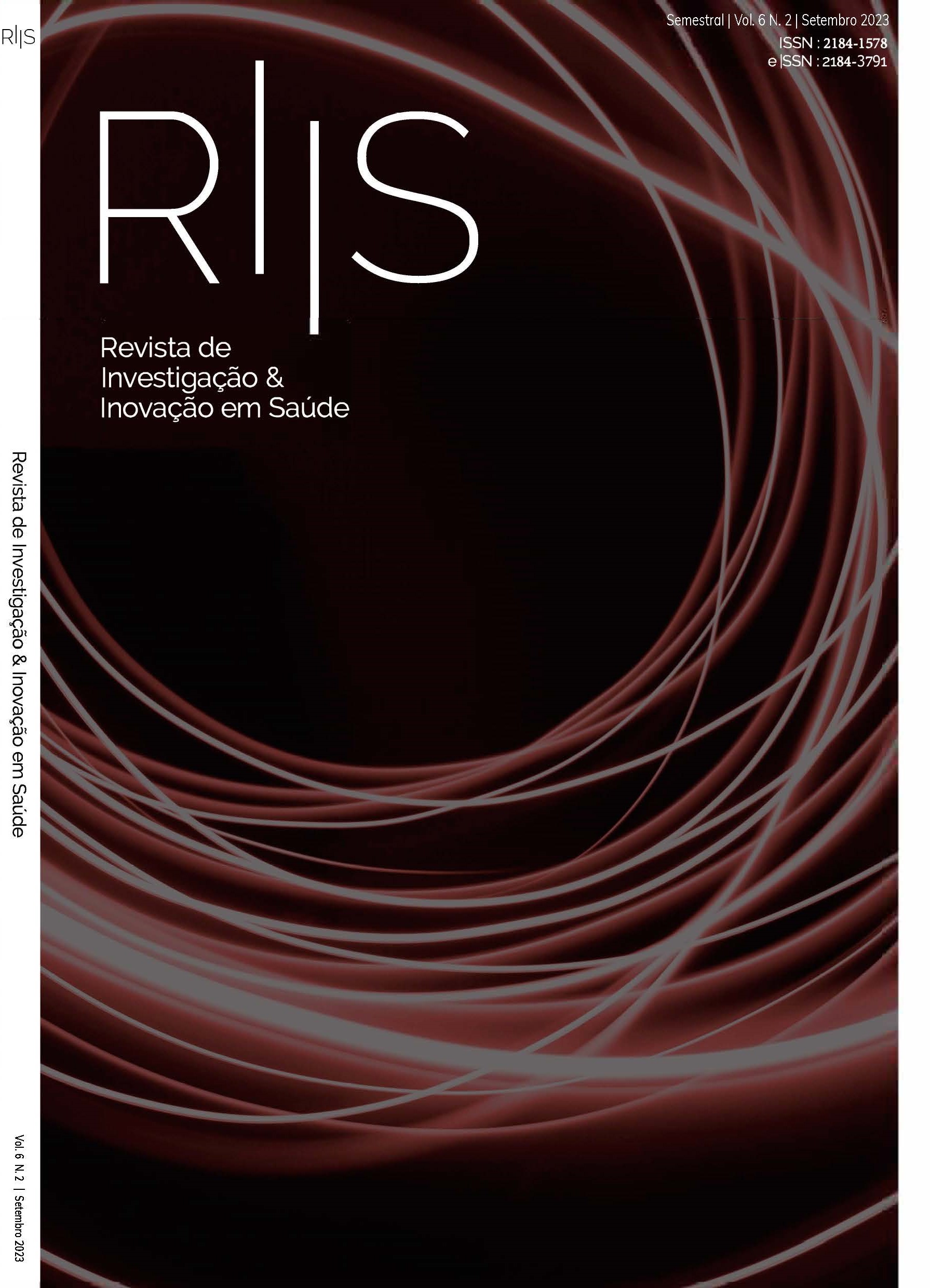Intervenções não farmacológicas dos enfermeiros à pessoa com delirium internada em cuidados intensivos – uma atualização
DOI:
https://doi.org/10.37914/riis.v7i2.334Palavras-chave:
cuidados de enfermagem, adulto, cuidados intensivos, deliriumResumo
Enquadramento: a pessoa com delirium representa um desafio aos profissionais de saúde, nomeadamente aos enfermeiros. Por outro lado, existem limitações importantes quanto ao tratamento farmacológico desta doença. Objetivos: identificar a eficácia de intervenções não farmacológicas em adultos com delirium implementadas pelos enfermeiros em cuidados intensivos. Metodologia: realizámos uma revisão integrativa, tendo recorrido a bases bibliográficas eletrónicas, nomeadamente EBSCO e Pubmed MEDLINE, para artigos publicados entre 2018 e 2022. O processo de seleção de artigos teve por base as recomendações da PRISMA (Preferred Reporting Items for Systematic Reviews and Meta-Analyses) para revisões sistemáticas. Resultados: foram incluídos no estudo nove artigos (n=9), dos quais seis correspondem a artigos originais, dois a meta-análises e uma revisão sistemática. A intervenção não farmacológica com maior evidência disponível foi a intervenção multicomponente, apesar da qualidade dos estudos limitar recomendações concretas em relação a esta abordagem. Conclusão: a evidência aponta para que uma personalização dos cuidados numa perspetiva complexa e integrada seja a abordagem não farmacológica do delirium com maior eficácia.
Referências
Álvarez, E. A., Garrido, M. A., Tobar, E. A., Prieto, S. A., Vergara, S. O., Briceño, C. D., & González, F. J. (2017). Occupational therapy for delirium management in elderly patients without mechanical ventilation in an intensive care unit: A pilot randomized clinical trial. Journal of critical care, 37, 85–90. https://doi.org/10.1016/j.jcrc.2016.09.002
Bannon, L., McGaughey, J., Verghis, R., Clarke, M., McAuley, D. F., & Blackwood, B. (2019). The effectiveness of non-pharmacological interventions in reducing the incidence and duration of delirium in critically ill patients: a systematic review and meta-analysis. Intensive Care Medicine, 45(1), 1–12. https://doi.org/10.1007/s00134-018-5452-x
Barichello, T., Generoso, J. S., Collodel, A., Petronilho, F., & Dal-Pizzol, F. (2021). The blood-brain barrier dysfunction in sepsis. Tissue Barriers, 9(1), 1840912. https://doi.org/10.1080/21688370.2020.1840912
Barr, J., Fraser, G. L., Puntillo, K., Ely, E. W., Gélinas, C., Dasta, J. F., Davidson, J. E., Devlin, J. W., Kress, J. P., Joffe, A. M., Coursin, D. B., Herr, D. L., Tung, A., Robinson, B. R. H., Fontaine, D. K., Ramsay, M. A., Riker, R. R., Sessler, C. N., Pun, B., … Jaeschke, R. (2013). Clinical Practice Guidelines for the Management of Pain, Agitation, and Delirium in Adult Patients in the Intensive Care Unit. Critical Care Medicine, 41(1), 263–306. https://doi.org/10.1097/CCM.0b013e3182783b72
Bento, A. F. G., & Sousa, P. P. (2021). Delirium in adult patients in intensive care: Nursing interventions. British Journal of Nursing, 30(9), 534–538. https://doi.org/10.12968/bjon.2021.30.9.534
Blevins, C. S., & DeGennaro, R. (2018). Educational Intervention to Improve Delirium Recognition by Nurses. American Journal of Critical Care, 27(4), 270–278. https://doi.org/10.4037/ajcc2018851
Guo, Y., Sun, L., Li, L., Jia, P., Zhang, J., Jiang, H., & Jiang, W. (2016). Impact of multicomponent, nonpharmacologic interventions on perioperative cortisol and melatonin levels and postoperative delirium in elderly oral cancer patients. Archives of Gerontology and Geriatrics, 62, 112–117. https://doi.org/10.1016/j.archger.2015.10.009
Guyatt, G., Oxman, A. D., Akl, E. A., Kunz, R., Vist, G., Brozek, J., Norris, S., Falck-Ytter, Y., Glasziou, P., & DeBeer, H. (2011). GRADE guidelines: 1. Introduction—GRADE evidence profiles and summary of findings tables. Journal of Clinical Epidemiology, 64(4), 383–394. https://doi.org/10.1016/j.jclinepi.2010.04.026
Hamzehpour, H., Valiee, S., Majedi, M. A., Roshani, D., & Seidi, J. (2018). The effect of care plan based on roy adaptation model on the incidence and severity of delirium in intensive care unit patients: A randomised controlled trial. Journal of Clinical and Diagnostic Research, 12(11). https://doi.org/10.7860/JCDR/2018/36366.12256
Inouye, S. K. (1990). Clarifying Confusion: The Confusion Assessment Method. Annals of Internal Medicine, 113(12), 941. https://doi.org/10.7326/0003-4819-113-12-941
Inouye, S. K., Westendorp, R. G., & Saczynski, J. S. (2014). Delirium in elderly people. The Lancet, 383(9920), 911–922. https://doi.org/10.1016/S0140-6736(13)60688-1
Jennings, K. M. (2017). The Roy Adaptation Model. Advances in Nursing Science, 40(4), 370–383. https://doi.org/10.1097/ANS.0000000000000175
Khan, S. H., Xu, C., Purpura, R., Durrani, S., Lindroth, H., Wang, S., Gao, S., Heiderscheit, A., Chlan, L., Boustani, M., & Khan, B. A. (2020). Decreasing Delirium Through Music: A Randomized Pilot Trial. American journal of critical care : an official publication, American Association of Critical-Care Nurses, 29(2), e31–e38. https://doi.org/10.4037/ajcc2020175
Keating, G. M. (2015). Dexmedetomidine: A Review of Its Use for Sedation in the Intensive Care Setting. Drugs, 75(10), 1119–1130. https://doi.org/10.1007/s40265-015-0419-5
Kim, B., Cho, J., Park, J. Y., Kim, H. E., & Oh, J. (2022). Delirium and Anxiety Outcomes Related to Visiting Policy Changes in the Intensive Care Unit During the COVID-19 Pandemic. Frontiers in Aging Neuroscience, 14(March), 1–9. https://doi.org/10.3389/fnagi.2022.845105
Lee, H. J., Bae, E., Lee, H. Y., Lee, S. M., & Lee, J. (2021). Association of natural light exposure and delirium according to the presence or absence of windows in the intensive care unit. Acute and Critical Care, 36(4), 332–341. https://doi.org/10.4266/acc.2021.00556
León-Salas, B., Trujillo-Martín, M. M., Martínez del Castillo, L. P., García-García, J., Pérez-Ros, P., Rivas-Ruiz, F., & Serrano-Aguilar, P. (2020). Multicomponent Interventions for the Prevention of Delirium in Hospitalized Older People: A Meta-Analysis. Journal of the American Geriatrics Society, 68(12), 2947–2954. https://doi.org/10.1111/jgs.16768
Matsuura, Y., Ohno, Y., Toyoshima, M., & Ueno, T. (2022). Effects of non-pharmacologic prevention on delirium in critically ill patients: A network meta-analysis. Nursing in Critical Care, May, 1–11. https://doi.org/10.1111/nicc.12780
Neelon, V. J., Champagne, M. T., Carlson, J. R., & Funk, S. G. (1996). The NEECHAM Confusion Scale: Construction, Validation, And Clinical Testing. Nursing Research, 45(6), 324–330. https://doi.org/10.1097/00006199-199611000-00002
Olmos, M., Varela, D., & Klein, F. (2019). ENFOQUE ACTUAL DE LA ANALGESIA, SEDACIÓN Y EL DELIRIUM EN CUIDADOS CRÍTICOS. Revista Médica Clínica Las Condes, 30(2), 126–139. https://doi.org/10.1016/j.rmclc.2019.03.002
Page, M. J., McKenzie, J. E., Bossuyt, P. M., Boutron, I., Hoffmann, T. C., Mulrow, C. D., Shamseer, L., Tetzlaff, J. M., Akl, E. A., Brennan, S. E., Chou, R., Glanville, J., Grimshaw, J. M., Hróbjartsson, A., Lalu, M. M., Li, T., Loder, E. W., Mayo-Wilson, E., McDonald, S., McGuinness, L. A., … Moher, D. (2021). The PRISMA 2020 statement: an updated guideline for reporting systematic reviews. BMJ (Clinical research ed.), 372, n71. https://doi.org/10.1136/bmj.n71
Poole, J., & Ray, D. (2022). The Role of Circadian Clock Genes in Critical Illness: The Potential Role of Translational Clock Gene Therapies for Targeting Inflammation, Mitochondrial Function, and Muscle Mass in Intensive Care. Journal of Biological Rhythms, 37(4), 385–402. https://doi.org/10.1177/07487304221092727
Pun, B. T., Balas, M. C., Barnes-Daly, M. A., Thompson, J. L., Aldrich, J. M., Barr, J., Byrum, D., Carson, S. S., Devlin, J. W., Engel, H. J., Esbrook, C. L., Hargett, K. D., Harmon, L., Hielsberg, C., Jackson, J. C., Kelly, T. L., Kumar, V., Millner, L., Morse, A., … Ely, E. W. (2019). Caring for Critically Ill Patients with the ABCDEF Bundle. Critical Care Medicine, 47(1), 3–14. https://doi.org/10.1097/CCM.0000000000003482
Trogrlić Z, van der Jagt M, Bakker J, Balas MC, Ely EW, van der Voort PH, Ista E. A systematic review of implementation strategies for assessment, prevention, and management of ICU delirium and their effect on clinical outcomes. Crit Care. 2015 Apr 9;19(1):157. doi: 10.1186/s13054-015-0886-9. PMID: 25888230; PMCID: PMC4428250.
Rains, J., & Chee, N. (2017). The role of occupational and physiotherapy in multi-modal approach to tackling delirium in the intensive care. Journal of the Intensive Care Society, 18(4), 318–322. https://doi.org/10.1177/1751143717720589
Schuckit, M. A. (2014). Recognition and Management of Withdrawal Delirium (Delirium Tremens). New England Journal of Medicine, 371(22), 2109–2113. https://doi.org/10.1056/NEJMra1407298
Wilson, C. J., Finch, C. E., & Cohen, H. J. (2002). Cytokines and Cognition-The Case for A Head-to-Toe Inflammatory Paradigm. Journal of the American Geriatrics Society, 50(12), 2041–2056. https://doi.org/10.1046/j.1532-5415.2002.50619
Downloads
Publicado
Como Citar
Edição
Secção
Licença
Direitos de Autor (c) 2024 Fábio Emanuel Quintal Fernandes, Orlando Ferro Fernandes, Isabel Abreu, Hugo Canas-Simião, Filipe Vieira Franco

Este trabalho encontra-se publicado com a Licença Internacional Creative Commons Atribuição 4.0.















